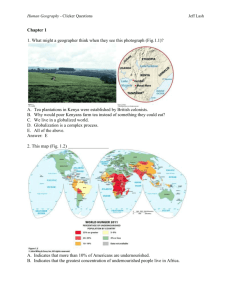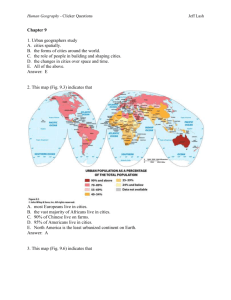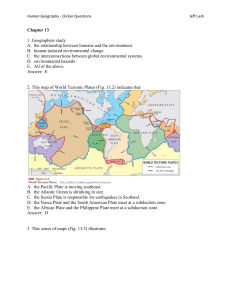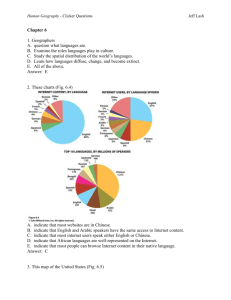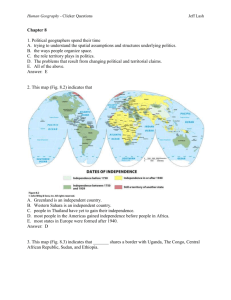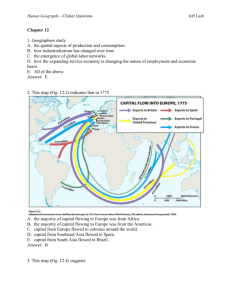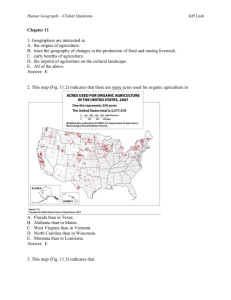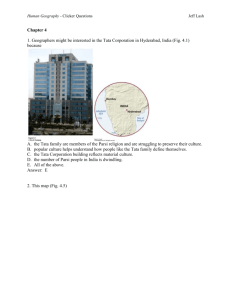Human Geography - Clicker QuestionsJeff Lash Chapter 7 1
advertisement
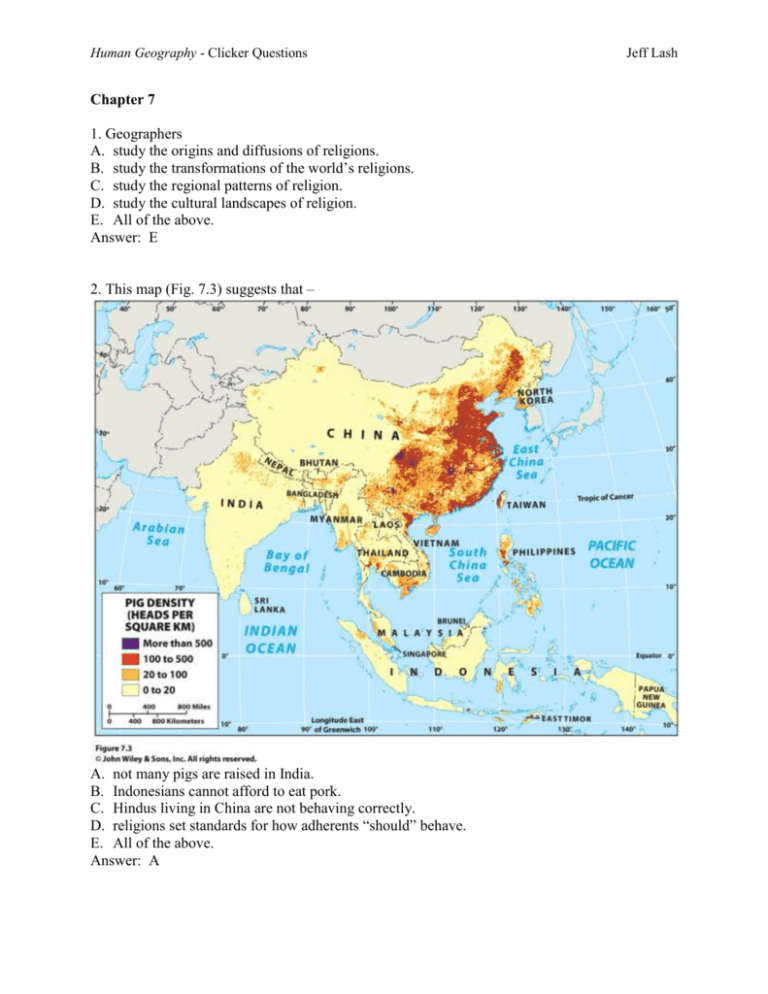
Human Geography - Clicker Questions Chapter 7 1. Geographers A. study the origins and diffusions of religions. B. study the transformations of the world’s religions. C. study the regional patterns of religion. D. study the cultural landscapes of religion. E. All of the above. Answer: E 2. This map (Fig. 7.3) suggests that – A. not many pigs are raised in India. B. Indonesians cannot afford to eat pork. C. Hindus living in China are not behaving correctly. D. religions set standards for how adherents “should” behave. E. All of the above. Answer: A Jeff Lash Human Geography - Clicker Questions 3. This figure (Fig. 7.5) suggests that A. Islam’s hearth is near the Yellow River. B. Islam and Christianity have nothing in common. C. Islam was created directly from Greek philosophy. D. Islam was influenced by Judaism and Greek philosophy. E. Islam is the only major religion to have a second-stage revolution. Answer: D 4. This map of world religions (Fig. 7.6) indicates Jeff Lash Human Geography - Clicker Questions A. that Mormanism is common throughout the United States. B. that southern Louisiana is mostly Protestant. C. that Tantrayana Buddhism is more wide-spread than Theravanda Buddhism. D. that the hearth of Shintoism is in South Korea. E. that Iranians practice the same religion as Russians. Answer: C 5. This photograph (Fig. 7.7) shows Jeff Lash Human Geography - Clicker Questions Jeff Lash A. the ruined Islamic mosque in Mecca, one of Islam’s sacred sites. B. the craftsmanship of early Buddhist colonists in China. C. the results of neglect and destruction of Hindu temples in India. D. the monumental Buddhist temples under construction in Qatar. E. the temple complex in Angkor Wat, site of the earliest period of Hinduism’s diffusion into Southeast Asia. Answer: E 6. This map (Fig. 7.12) reflects Human Geography - Clicker Questions A. the split between Roman Catholics and Protestants. B. the split between Christianity and Islam in the late 18th century. C. the split between Christians and Jews at the end of the 15th century. D. the split between the Eastern Orthodox Church and the Roman Catholic Church. E. the split between the Roman Catholic Church and Shia Islam. Answer: D 7. This photograph (Fig. 7.15) reflects the fact that Jeff Lash Human Geography - Clicker Questions Jeff Lash A. Islam has made a strong imprint on the cultural landscape in Malaysia. B. Hinduism has made a strong imprint on the cultural landscape in Saudi Arabia. C. minarets are a common element of the cultural landscape in Japan. D. adherents of Shintoism believe that locating airports next to temples brings good luck. E. None of the above. Answer: A 8. This map (Fig. 7.16) indicates that Human Geography - Clicker Questions A. Islam spread into southeastern Europe under the influence of the Ottoman Empire. B. Islam’s hearth is in the Arabian Peninsula. C. Muslim travelers spread Islam to East Africa and Indonesia. D. by 1600, Islam had spread across the entire Sahara. E. All of the above. Answer: E 9. This photograph (Fig. 7.22) illustrates Jeff Lash Human Geography - Clicker Questions Jeff Lash A. the fact that for Hindus the Ganges river is sacred. B. the fact that for Hindu it is a duty to bath in river water every day. C. the fact that Muslims in India have no rights and must bath in river water. D. the fact that Muslims believe that Muhammad ascended to heaven from the Indian city of Varanasi. E. None of the above. Answer: E 10. The white spaces on this map (Fig. 7.37) indicate Human Geography - Clicker Questions A. no ethnic diversity. B. no ethnic data is available. C. areas with few people. D. extreme ethnic diversity. E. Where Serbs had monasteries in the 13th century. Answer: D Jeff Lash
